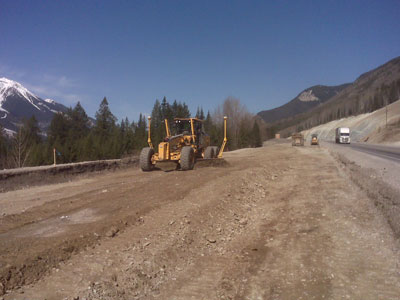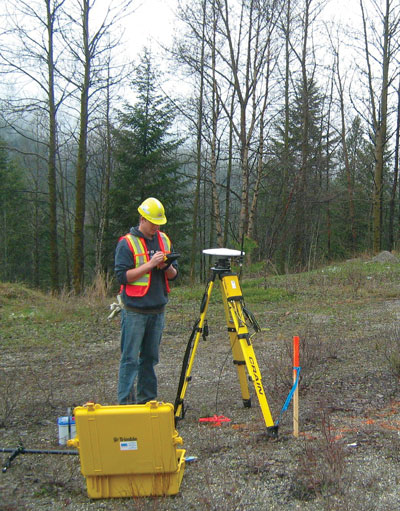
Features
Company Profiles
Roads & Paving
Short Learning Curve
Contractor experiences benefits of GPS grade control technology on a stretch of the world’s longest
October 17, 2011 By Jeff Winke
Some trivia to use for stumping the know-it-alls:
- The Trans-Canada Highway runs between Victoria, British Columbia and St. John’s, Newfoundland.
- It is the world’s longest national highway with a length of 7,821 kilometres.
Some trivia to use for stumping the know-it-alls:
- The Trans-Canada Highway runs between Victoria, British Columbia and St. John’s, Newfoundland.
- It is the world’s longest national highway with a length of 7,821 kilometres.
 |
|
| Vancouver, B.C.-based Ledcor CMI Ltd. performed a $62-million road construction project on the Trans-Canada Highway, which included straightening and widening to four lanes a 9.6-kilometre stretch of the roadway that cuts through the shale and limestone Rocky Mountains. The new road makes travel easier and safer for motorists and truckers.
|
Something that’s not trivial is a major, $62-million Trans-Canada Highway (TCH) road construction project being performed by Vancouver, B.C.-based Ledcor CMI Ltd. With approximately 120 workers onsite, Ledcor CMI straightened and widened to four lanes a winding and twisting 9.6-kilometre stretch of the TCH that cuts through the shale and limestone Rocky Mountains. The new road makes travel easier and safer for motorists and truckers.
The project was commissioned by the Ministry of Transportation and Infrastructure in British Columbia. Ledcor CMI is the prime contractor for the project.
“We received a paper-plan design provided by the Ministry’s engineers, which we converted to a digital plan for our use,” states Brad Steane, EIT (Engineer in Training), field engineer with Ledcor. “We created a road plan using our Trimble software to create road alignments and contours, and from there a template that gave us the whole road profile, which we were able to use.”
The TCH road project was Ledcor CMI’s first experience with Trimble software. The program uses a single-file project-model for construction tasks such as calculating cut/fill volumes, creating stakeout data and reports, calculating mass haul and construction phasing, preparing data for machine control, and producing as-built survey records during construction. The program creates a single-file 3-D model from a paper plan.
“Our Trimble dealer, Mountainview Systems based in Calgary, Alta., was instrumental in helping us learn the Trimble software,” Steane says. “They organized three days of individualized training to help us with the Trans-Canada Highway road project – including everything from data collection to model building to developing volumes, etc.”
Before excavation and grading could begin, Ledcor CMI had “lots of clearing, drilling, and blasting” to do. The clearing and grubbing portion required about three months to complete. Work started in October 2008 and by the time they finished, Ledcor CMI had cleared 63 hectares of timber and had moved 388,000 cubic metres of common material and 323,000 cubic metres of rock. At the peak of the project, there were 17 rock trucks moving materials around the site.
 |
|
| Crews working on the Trans-Canada Highway project used Trimble hardware and software to create a model of all the different surfaces.
|
“We completed our own surveys with our Trimble gear, and then used the Trimble software to create a model of all the different surfaces for reconciling the volumes,” says Steane. “We were able to use our more accurate volumes to justify higher rock quantities with the Ministry versus the common cut quantities they provided. This paid off immensely since we could accurately justify a higher cost claim for the additional rock.” The removed rock was used to fill in the deep gullies that the old road had skirted.
“The 3-D digital model created with the Trimble software was a huge help when staging and providing information, such as volume estimates for the superintendents and foremen,” Steane states. “In fact, the Trimble systems provided stronger surveying capabilities than initially expected. It allowed us to efficiently and accurately use the 3-D model with the SCS900 software for layout, enabling us to meet our survey requirements in house.”
Ledcor CMI equipped its Volvo G990 motor grader with a dual GPS Trimble GCS900 Grade Control System. This is a full 3-D control system that puts the site plan – design surfaces, grades and alignments – inside the cab, viewable on the Trimble CB430 screen in plan, profile, and cross-section views, or text formats.
“We outfitted the grader just as we were working on the subgrade,” states Steane. “We wanted to pass approvals, so we relied heavily on the Trimble system to help us achieve the tolerances in our subgrades right through to finish grade. In the gravel sections as well, we used two other graders to bulk in the material and then finished with the Trimble GCS900-equipped Volvo to easily achieve the 15 millimetres gravel tolerance we needed to hit.”
Two 300-millimetre lifts of gravel were placed before the asphalt paving. The asphalt surface consisted of two lifts, 50 millimetres each.
“We received strong positive feedback from the Ministry of Transportation on the quality of our subgrade and finish grading,”
Steane reports. “They told us it was ‘some of the nicest grade work that they had ever seen.’ It was interesting to see their attitude change over the life of the project. When we first got on the site, the Ministry was very, very thorough about which areas they checked. Then, after seeing what we were accomplishing with the Trimble GCS900 system, they decided to just spot check a few areas and basically approve what we had done based on what the Trimble system reported. They became very trusting of our results.”
The TCH road project was a bit of a technology learning curve for all involved. “Just like our company, the Ministry of Transportation was learning the advantages of GPS grade control,” says Steane. “It was new to both of us.”
Compared to the total length of the transcontinental highway, the 9.6 kilometres that Ledcor CMI Ltd. worked on may not seem like much. “We faced some tough challenges working in the rugged Rocky Mountains terrain,” Steane states. “We had volumes of timber and rock to move in order to carve out new sections of road. We had started out with a single receiver mast on the motor grader, which had satellite reception issues when grading against high rock walls. Trimble’s dual-mast system greatly improved things.”
The project was completed ahead of schedule and within budget.
“The one thing I’ll always remember about this project is how we began to move away from old thinking and old ways of doing things,” Steane recalls. “A good example is how our main grader operator, who has probably been running a grader longer than I’ve been alive, had to adapt. At the beginning of the project, he wanted absolutely nothing to do with running a GPS-controlled grader, since he had a wealth of experience, skill and intuition. Our Trimble technician, who was up here at the time, set things up for him, basically said, ‘Just shut everything off’ and let it run without the technology. Then the technician slowly started turning on the different features so the operator could see how it worked. Within about three weeks the operator went from total distrust to becoming its biggest fan. The transition was great to see. It really demonstrated how the whole Trimble GCS900 system is intuitively set up for the machine operator.”
Ledcor CMI completed its work in November 2010 and the crew members who worked on that 9.6-kilometre segment of the world’s longest national highway are confident that it’s currently the best stretch of the highway in the country.
Jeff Winke is a business and construction writer based in Milwaukee, Wis.
Print this page